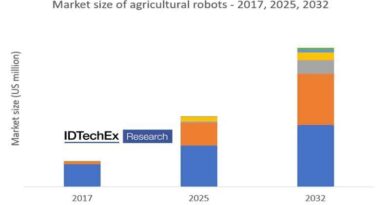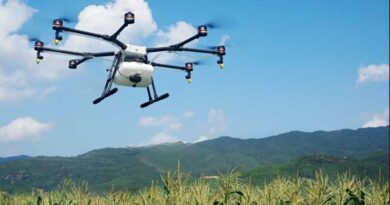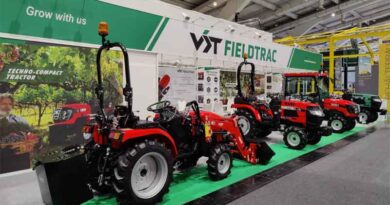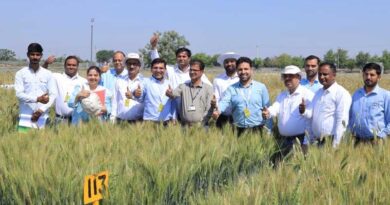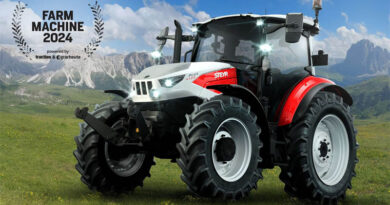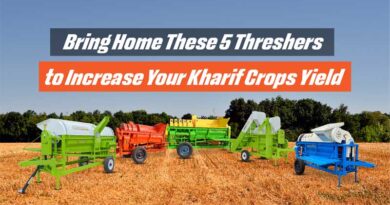Agricultural Robots Industry: Innovating Solutions for the Challenges of Modern Farming
28 June 2024, New Delhi: Agriculture Robots Market is rapidly expanding, driven by a diverse range of applications and types that are revolutionizing farming practices. These applications include agricultural inventory management, weather tracking and forecasting, pruning management, spraying, irrigation management, dairy farm management, field mapping, harvesting management, and soil management. Various types of agriculture robots cater to these applications, such as spraying robots, automated harvesting systems, milking robots, drones or unmanned aerial vehicles (UAVs), and driverless tractors. Each of these robotic systems plays a crucial role in enhancing efficiency, precision, and productivity in agriculture, addressing the industry’s pressing challenges and paving the way for a more sustainable and technologically advanced future.
Agriculture robots are spearheading a quiet revolution in the heart of fields and orchards. These cutting-edge machines are transforming traditional farming practices while tackling critical issues like labor shortages, climate change, and the imperative for sustainable agriculture. The integration of robotics into farming exemplifies human ingenuity and our relentless quest for efficiency and innovation. As these machines continue to advance, they are poised to reshape the agricultural landscape, enhancing productivity and promoting sustainability.
The Rise of Agriculture Robots
The integration of robotics into agriculture has surged, addressing labor shortages and increasing efficiency. Historically, agriculture has evolved through various technological advancements, from the invention of the plow to the development of modern irrigation systems. Today, the agricultural sector stands on the brink of another significant transformation with the advent of robotics. Several factors are driving this change, including the rising global population, the increasing demand for food, and the declining availability of farm labor. Robots offer a solution to these challenges by performing tasks with greater precision and efficiency than human labor. This shift towards automation is not just about replacing human workers but about enhancing productivity and ensuring the sustainability of agricultural practices in the long run.
Types of Agriculture Robots
From planting to harvesting, various types of robots are now performing tasks once done by human hands. Autonomous tractors and drones are revolutionizing field management, allowing farmers to cover large areas quickly and efficiently. These machines can plant seeds, apply fertilizers, and monitor crop health with unparalleled precision. Harvesting robots are another significant development, capable of picking fruits and vegetables with the delicacy required to avoid damage. Weeding and planting robots are designed to identify and remove weeds, ensuring that crops receive the nutrients they need to thrive. Monitoring and maintenance robots use advanced sensors and AI to keep track of plant health, soil conditions, and pest activity, providing farmers with real-time data to make informed decisions.
Benefits of Agriculture Robots
The deployment of robots in agriculture offers numerous advantages, transforming traditional farming practices. One of the most significant benefits is increased productivity and efficiency. Robots can work around the clock, unaffected by fatigue or adverse weather conditions, leading to higher yields. Their precision in tasks such as planting and spraying ensures optimal use of resources, reducing waste and improving crop quality. Additionally, the use of robots reduces labor costs and the reliance on seasonal workers, which can be scarce and expensive. This is particularly beneficial in regions where labor shortages are a chronic issue. Furthermore, robots enhance sustainability by minimizing the use of chemicals and reducing the environmental footprint of farming. By enabling more precise application of fertilizers and pesticides, robots help in maintaining soil health and reducing water contamination.
Challenges and Limitations
Despite their potential, agriculture robots face several challenges that must be addressed to ensure their widespread adoption. One of the primary obstacles is the high initial cost and investment required to acquire and maintain these machines. Small-scale farmers, in particular, may find it difficult to afford such technology. Technical complexities and the need for regular maintenance also pose significant challenges. Robots must be reliable and durable to operate effectively in the harsh conditions often found in agriculture. Additionally, integrating these robots with existing farming practices and systems can be complex and require substantial changes. Ethical considerations and the potential impact on the labor market are other important factors to consider. The displacement of human workers and the need for new skill sets for managing and maintaining robots are issues that need careful management.
Case Studies: Successful Implementations
Several farms and agricultural enterprises have already embraced robotics, showcasing successful implementations. For instance, a large-scale vegetable farm in California has integrated robotic harvesters into its operations, significantly increasing efficiency and reducing labor costs. These robots can identify ripe produce and pick it without damaging the plants, ensuring a high-quality yield. In vineyards across Europe, drones are used for crop monitoring, providing detailed aerial images that help farmers assess the health of their vines and make precise interventions. Another example is the use of autonomous tractors in grain production in the Midwest, where these machines have reduced the time and labor required for planting and harvesting. These case studies highlight the practical benefits of robotics in agriculture and demonstrate the potential for broader adoption.
The Future of Agriculture Robots
As technology continues to evolve, the future of agriculture robots looks promising, with new advancements on the horizon. Emerging technologies such as AI and machine learning are expected to make robots even more intelligent and capable. These advancements will enable robots to perform more complex tasks, adapt to changing conditions, and make autonomous decisions based on real-time data. The potential impact on global food production is immense, with the ability to increase yields, reduce waste, and improve the overall efficiency of farming practices. Looking ahead, the next decade is likely to see significant developments in agriculture robotics, with more widespread adoption and integration into farming operations worldwide. This evolution will not only enhance productivity but also contribute to the sustainability and resilience of the agricultural sector.
These insights are based on a report on Agriculture Robots Market by Transparency Market Research
(For Latest Agriculture News & Updates, follow Krishak Jagat on Google News)
(+80 Million Farming Audience Visits Krishak Jagat’s Hindi Website – Click Here for Website)


